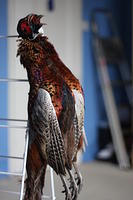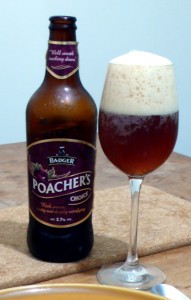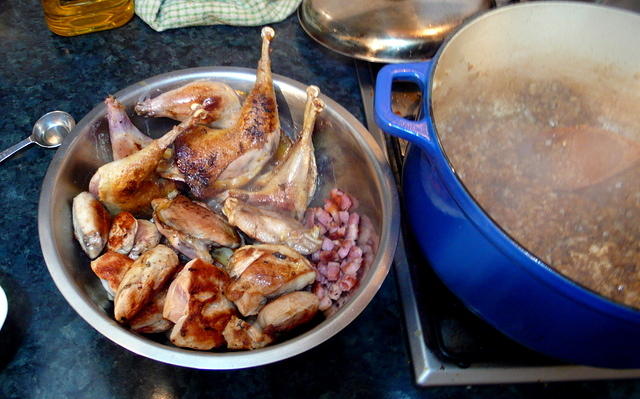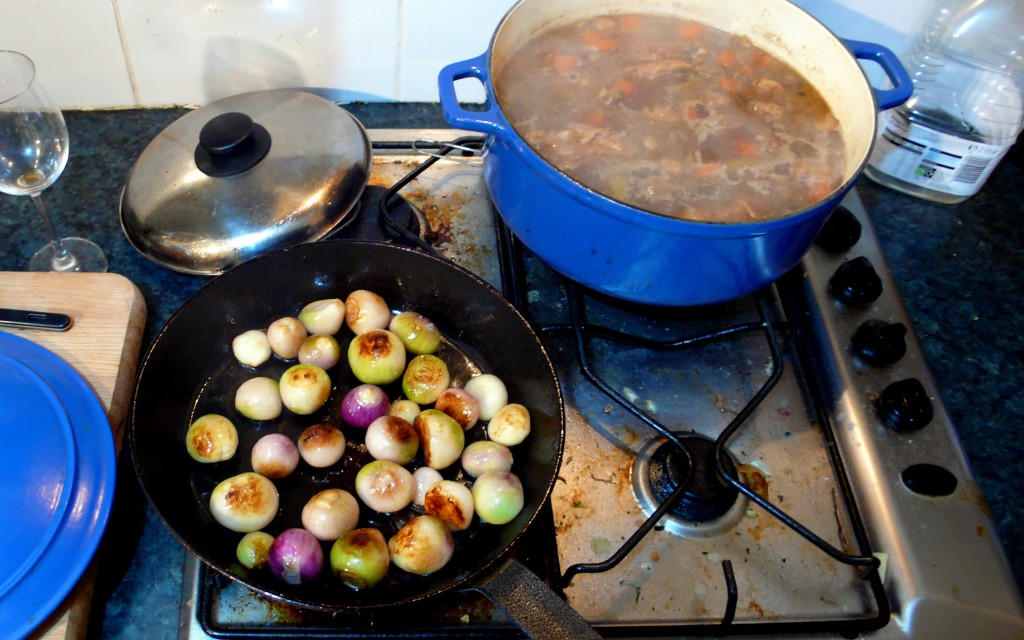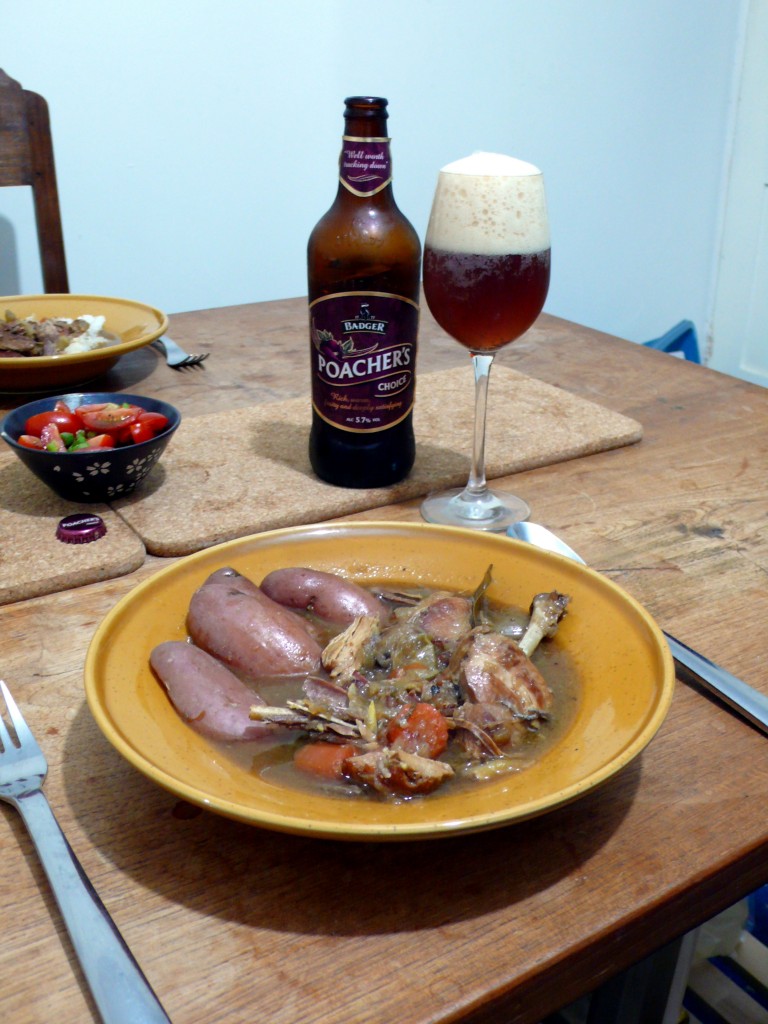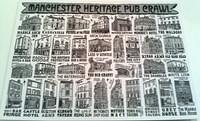
Manchester Pubs
When visiting a new city or town for an evening or more I usually do a bit of a Google to find the most recommend pubs in the area (the Good Beer Guide is both too large to lug around and has a bad habit of directing me to terrible pubs.) In the case of our trip to Manchester for the National Winter Ales Festival we already knew about one pub at least: the famous Marble Arch brewpub. We found out about another through a recommendation from a friend on Twitter: The Las O’Gowrie. The third pub we found in Manchester entirely by chance: The Old Wellington. There’s also a fourth pub in this saga: The Euston Tap. Since our train from Manchester landed us in Euston at about 17:30 a trip to this bright new star of the craft beer scene was inevitable.
In the order we visited them I present the pubs of our great Manchester National Winter Ales Festival excursion.
The Old Wellington
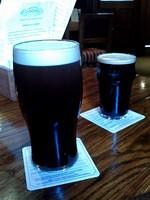
Thornbridge “Wild Holly”
Our only pub “discovery” of the trip was made in passing. As we headed toward the Manchester Cathedral we passed a somewhat historic looking pub and peered through the window… we spied a BrewDog logo! Alpha Dog! A brew we’d not tried before. It was tasty and quite bitter with a distinct Horlicks malt note on the nose. Somewhat reminiscent of the, much stronger, Dogma. I wonder if there is something similar in the recipe.
The pub was the The Old Wellington, situated between the Manchester Cathedral and the Manchester Arndale (possibly the biggest “mall” I’ve ever seen, mammoth in fact, quite horrid.) We also tried Thornbridge’s “Wild Holly” and a Vicious “American Wheat IPA”. The “Wild Holly” was interesting, passed through the sparkler into a tulip beer glass it came out and settled looking almost exactly like a pint of Guinness. That’s where the similarity ends, this beer had a flavour reminiscent of lightly smoked sweetcure bacon. There were a couple of other ales on, 6 handpumps in all I think.
A couple of interesting beer facts about this pub: half the beer was dark & the pumps were all fitted with sparklers. The latter was probably why our beers were served a bit on the short side: About 1cm of foam, despite the fact that gruff and grumpy-looking young barman seemed to make some effort to top the beers up. Aside from that small issue all the beers we tried were flavoursome and in excellent condition.
We liked The Old Wellington enough that we returned on our last day in Manchester to try the food. (Rather than risk some other random pub of unknown beer quality.) The verdict: great pub food, well executed. My lamb shank pie was excellent with a crisp puff lid and rich gravy. To double our luck the BrewDog Alpha Dog had been replaced by cask 5AM Saint: this hoppy & robust beer went well with the lamb pie. The only negative: being Saturday, the place was busy. However this did give us the chance to see more of the interior of the building, which has a remarkable history, it’s worth looking around.
I noticed from the licensing information that the pub was owned by Mitchells & Butlers. Wonders never cease I suppose.
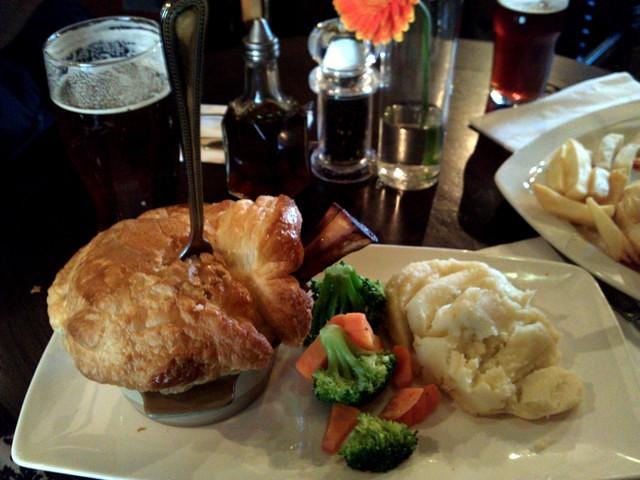
Lamb Shank Pie
The Marble Arch

Marble Arch tilework
After our stop at the The Old Wellington we took a chilly wander up to the Marble Arch. (Get a website dudes!) This is the brewpub and brewery-tap of Marble Brewery, a mighty fine pub it is too. The bar area is characterful, with great tiling (I presume this is original) and a floor that slopes down toward the bar. If you’ve had a few don’t worry: it’s the floor that’s tipping you toward the bar, not the beer (perhaps!) This is a true historic treasure of an old public house.
The selection of Marble beers here is, of course, excellent. Bonus: the selection of cheese is also excellent. We had a 9-cheese platter and the cheese was so good that I’ll forgive the fact that one of my stiltons seemed to have magically become a brie. Marble’s strong Chocolate Dubbel was a most excellent accompaniment to my selection of strong-flavoured cheese. I liked the Dubbel so much that we bought an expensive 75cl bottle of it to take home.
We tried a few other Marble beers at the pub and one of the most memorable was the “Ginger”. Comparing this to the (competing?) Robinson’s “Ginger” we had the previous day at the NWAF was an interesting exercise. I like both, but easily prefer Marble’s offering. The Marble “Ginger” tastes like beer with a big hit of ginger, the Robinson’s “Ginger” tastes like ginger-beer.
We’d had a few pints by this stage of the day and sensibility dictated that we make our way back to the hotel for a break and some dinner. We were up for another trip to the NWAF in the evening. I’d have loved to visit the Marble Arch again but we didn’t get the opportunity, I’ll certainly be back should I be in Manchester again. NWAF 2012?
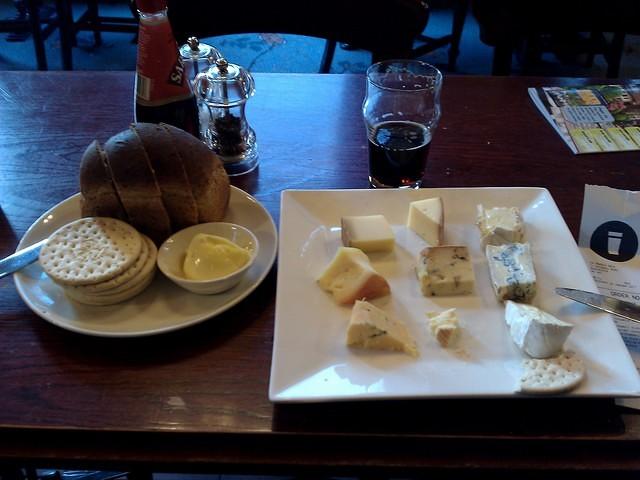
Cheese and Chocolate Dubbel!
The Las O’Gowrie
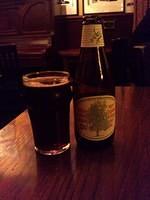
Anchor Beer
Our third pub of the trip was the Las O’Gowrie – advertised to us as “good but studenty”. We popped in here after dinner on our final night (Friday) after spending the afternoon at our third NWAF session. To be honest we found the cask ale a bit average – but adequate. I suspect we might have just been a little unlucky with the guests. What was there was half Greene King (IPA, Abbot, and XX Mild) and half low ABV “session bitters”. The session ales were not bad, mind you, the Betty’s Bitter was tasty despite the low ABV. But after a day sampling imperial stouts we wanted something with a bit more body. We quickly moved on to the small but decent selection of bottled foreign beers. The highlight bottled beer was the Anchor “Merry Christmas and Happy New Year” – a dark, herbal, spiced beer that was quite quaffable for a its 5.5% ABV.
The Friday night crowd in the pub was mixed and only notable as we’d been told to expect it to be “studenty”. In truth there were more over-30s than under-30s in the bar, and it only felt “a bit studenty” to me. (Yes, there are plenty of over-30 students, I know… but these probably weren’t them.) That said, the place was definitely geeky. Walls adorned with old computer game relics and original graphic novel prints, most by by cartoonist Ade Salmon. We grabbed a corner in the snug “snug” and sunk a few beers before heading back to the hotel (about 300m up the road.)
In real ale terms the Las O’Gowrie goes down in my books as “well worth a visit if you’re nearby”. As a visitor I wouldn’t trek across town for the place, but if I lived next door I’d be a regular.
The Euston Tap
If you follow the UK beer Twitterati and bloggerati then you’ll have heard of the Euston Tap. The amount of positive feedback I’ve heard about this place is possibly unrivalled. It’s a relatively new bar residing in one of the gatehouses of Euston station, I recall it having once been a café. The Euston Tap is known for its “craft ale”, as opposed to “real ale” – and most of its craft ale fame amongst people I follow stems from their supply of beers from the US. That said, on advertising the Euston Tap to a contact I referred to it as “not real-aley” – then felt immediately silly, there’s 8 cask lines! It’s just that there are another 19 lines stocked with the best of UK, European, and US kegged beers.

Beer List: Left

Beer List: Right
Stepping into the place you’re right in front of the bar, which is backed by a wall covered in beer taps. The public area is a U-shape around this bar with some stools to the outer edges and a spiral staircase in one corner. Both back walls, either side of the bar, are taken up with large glass-doored refrigerators, above which are blackboards advertising the list of draught beers available. Essentially you walk through the door to be met by an entire wall of beer. A little dizzying for this beer geek! Especially when you look closer. The draught and bottle selection is made up of local and international names of renown, and more exciting still, there’s bits and bobs unheard of to all but regulars and the seriously hardcore beer geeks. Beers known and loved, beers heard-of and wished-for, beers unknown – waiting to be discovered! OK, I’m getting a little melodramatic now.
So, what did we sup? We kicked off with a couple of cask ales, not wanting to let the side down – we were on our way home from the CAMRA National Winter Ales Festival after all! The Osset “Big Red” and Darkstar “Partridge” wet out whistles well. After this we moved on to the US, Kat on dark beers and me on pale ales. Sierra Nevada “Stout” was a tasty dry brew and Anchor “Porter” chocolaty dessert. The pale ales were Stone “Cali-Belgique”, Matuska “Raptor”, and Odell “5 Barrel”; to be honest the latter two didn’t do it for me, the Stone was smooth and very drinkable. None of them provided the hop-bomb I was hoping for.
Moving back the locals solved this. Thornbridge “Raven”, that most fashionable of oxymoronic beasts, a “Black IPA”. All big dark stout flavours with punchy aromatic hops. I stuck with this for another half, followed by an accidental pint (surely I wasn’t slurring my words yet?) Truly happy we then went home with a couple of bottles of US imperial stout (oh my poor wallet and liver.)
So, verdict? The Euston Tap is, at this moment, my favourite pub in London. Though I’m perfectly happy in several others: The Rake, The White Horse (especially for bottled beers), and the Market Porter when I’m in a cask ale mood (often.) The Euston tap has the best range of draught beer I’ve seen so far in the UK.
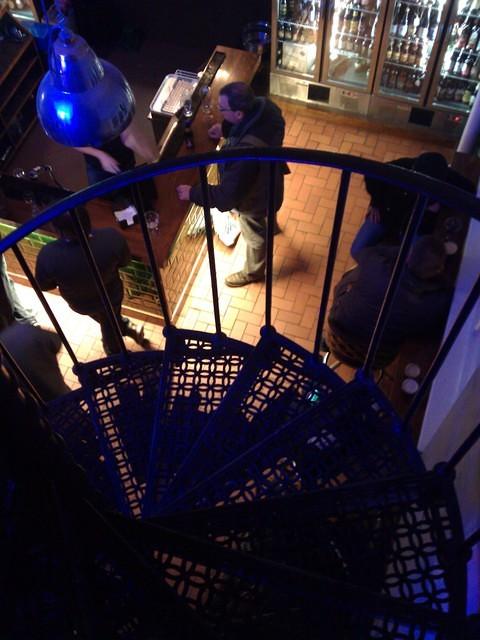
Spiral Staircases Rock
Not much else to say…
Get yourself to the National Winter Ales Festival in 2012. Enjoy the beer, but also remember to enjoy the pubs. Remember that it is excellent pubs like these that keep the beer world pumping.
